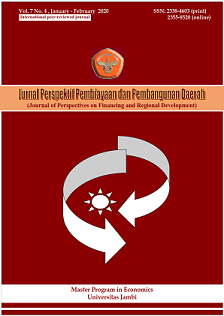Stock-return volatility persistence over short and long range horizons: Some empirical evidences
DOI:
https://doi.org/10.22437/ppd.v7i4.8795Keywords:
Forecasting models, Memory failure, Nigeria, Short range and long range horizons, Stock-return volatilityAbstract
In this paper, we account for memory failure or otherwise in the daily evolution of stock return and volatility within the purview of short and long ranges based on the arrival of fundamental news. This accounts for the return on assets in the current period to be a function of returns realized in the pasts. To achieve this objective, we estimated ARMA, ARFIMA, GARCH, FIGARCH and HYGARCH models. After implementing maximum likelihood estimation technique, we found out that the ARMA coefficients were not significant, the GARCH coefficients were significant and the memory coefficients in terms of ARFIMA, FIGARCH and HYGARCH were statistically significant. In the light of these, we propose the rejection of efficient hypothesis in the long range and document a single memory in volatility in the short range. The study recommends that ARFIMA and HYGARCH are the best forecasting models for return and volatility respectively in the Nigerian stock market.
Downloads
References
Andersen, T.G., Bollerslev, T. Diebold, F. X., & Ebens, D. H. (2000). The distribution of stock return volatility. Journal of Financial Economics, 61, 43-76.
Baillie, R. T.,Bollerslev, B. T., & Mikkeslen, H. O. (1996). Fractionally integrated generalized autoregressive conditional heteroscedasticity. Journal of Econometrics, 74, 13–30.
Balibey, M., & Turkyilmaz, S. (2014). Value-at-Risk analysis in the presence of asymmetry and long memory: The case of Turkish stock market. International Journal of Economics and Financial Issues, 4(4), 836-848.
Bianco, S., Corsi, F., & Ren`o, R., (2008). Serial correlation and heterogeneous volatility in financial markets: Beyond the LeBaron effect, Arxiv: 0810.491v1(q-fin-ST).
Bollerslev, T. (1986).Generalized autoregressive conditional heteroscedasticity. Journal of Econometrics,31, 307–327.
Bollerslev, T., Osterrieder, D., Sizova, N., & Tauchen, G. (2013). Risk and return: Long-run relations, fractional cointegration and return predictability. Journal of Financial Economics, 108, 409–424.
Booth, G. G., & Koutmos, G. (1988).Volatility and autocorrelation in major European stock markets. European Journal of Finance, 4, 61–74.
Brock, W.A., Dechert, W.D., & Scheinkman, J. (1987). A test for independence based on the correlation dimension. Discussion Paper 8702, University of Wisconsin-Madison.
Campbell J., Grossman, S. J., & Wang, J. (1993). Trading volume and serial correlation in stock returns. Quarterly Journal of Economics, 108(4), 907-921.
Chikhi, M., Peguin-Feissolle, A., & Terraza, M. (2013). SEMIFARMA-HYGARCH modelling of Dow Jones return persistence. Computational Economics, 41(2), 254-261.
Davidson,J. (2004). Moments and memory properties of linear conditional heteroscedasticity models and a new model. Journal of Business and Economic Statistics, 22, 16-29.
David, J.M., & Simonovska, I. (2015).Correlated beliefs, returns, and stock market volatility.UC Davis, NBER.
Günay, S. (2014). Long memory property and structural breaks in volatility: Evidence from Turkey and Brazil. International Journal of Economics & Finance, 6(12), 119-130.
Hongngoc, T. (2014). Arfima-Figarch vs .Arfima-Hygarch: Case study ETF returns of emerging Asian Countries. Asian Journal of Finance & Accounting, 6 (2), 176-192.
Mohammadi, F., & Rezakhah, S. (2017). Smooth transition HYGARCH model: Stability and forecasting. Arxiv: 1701.05358v1 (Stat.CO).
Watanabe, T. (2002). Margin requirements, positive feedback trading, and stock return autocorrelations: The case of Japan. Applied Financial Economics, 12, 395-403.
Zhou, D., Chen, S., & Dong, S. (2012). Network traffic prediction based on ARFIMA model. IJCSI International Journal of Computer Science Issues, 9(6), 106-111.
Downloads
Published
How to Cite
Issue
Section
License
Copyright (c) 2020 Kolawole Subair, Ajibola Arewa

This work is licensed under a Creative Commons Attribution 4.0 International License.

















